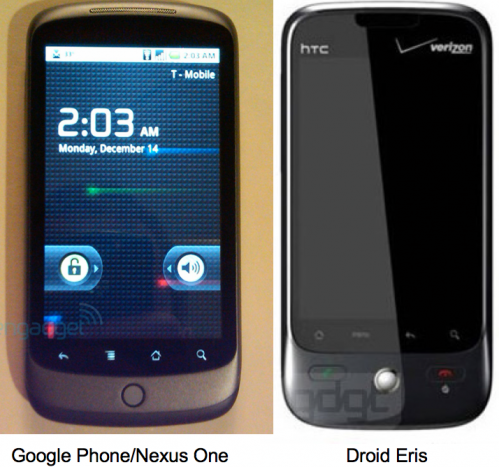The Google Phone/Nexus One Was (Briefly) In My Hand
Yesterday after I had coffee with someone (who is not a Google employee) I was briefly given the “Nexus One” to look at and fondle. I was not permitted to take a photo of it but did have a chance to do a few things on it and was able to form a few “first […]
Yesterday after I had coffee with someone (who is not a Google employee) I was briefly given the “Nexus One” to look at and fondle. I was not permitted to take a photo of it but did have a chance to do a few things on it and was able to form a few “first impressions.” Here are my admittedly superficial thoughts:
- It looked to me like a thinner Droid Eris with a larger, more impressive screen (both are made by HTC; Nexus One has no “Sense” interface)
- The screen resolution was great and crisp
- The stand-out dimension of the phone in my brief time with it was its speed; it was extremely fast (running on the T-Mobile network)
- It features the “new” version of the Android Market, which is a considerable step up from what exists now
- A surprise and disappointment: no multi-touch
Here are a couple of images of the Nexus One and Eris (via Engadget):

This is clearly now the “flagship” Android device; it’s no longer the Motorola “Droid.” In many ways the Droid is clunky and awkward by comparison.
It appears to be faster than the iPhone 3GS but I didn’t have any side-by-side comparison opportunity. It has multi-tasking and Google Navigation, Voice Search and so on. But the iPhone still represents a more “complete” and “integrated” device in my view. Others will probably disagree. Indeed, this is probably the first Android device that is a true substitute for the iPhone. That represents danger for Apple unless it comes out from under the AT&T relationship next year; Android could blunt iPhone sales.
How this phone performs commercially is obviously yet to be determined and will be contingent in large part on its price. Some arrangement exists with T-Mobile but not yet AT&T apparently, although AT&T is reportedly about to release its own Android device (the “Back Flip“). So we may see it emerge at AT&T, especially as the carrier loses iPhone exclusivity (anticipated) in the next year. The phone will only operate on GSM networks, which are widespread outside the US but only T-Mobile and AT&T domestically.
Google is certainly trying to build the best phone it thinks Android can be and trying to push the envelope through an expected direct sale to the public. As others have pointed out maybe this is directed primarily to markets outside the US where people are more accustomed to buying phones directly and not as much through carriers. But the “carrier subsidy” or some version of that is critical to the adoption of this phone.
Ultimately whether this Android phone or that Android phone succeeds is immaterial to Google, just that there are many Android phones operating in the market.
Contributing authors are invited to create content for Search Engine Land and are chosen for their expertise and contribution to the search community. Our contributors work under the oversight of the editorial staff and contributions are checked for quality and relevance to our readers. The opinions they express are their own.
Related stories